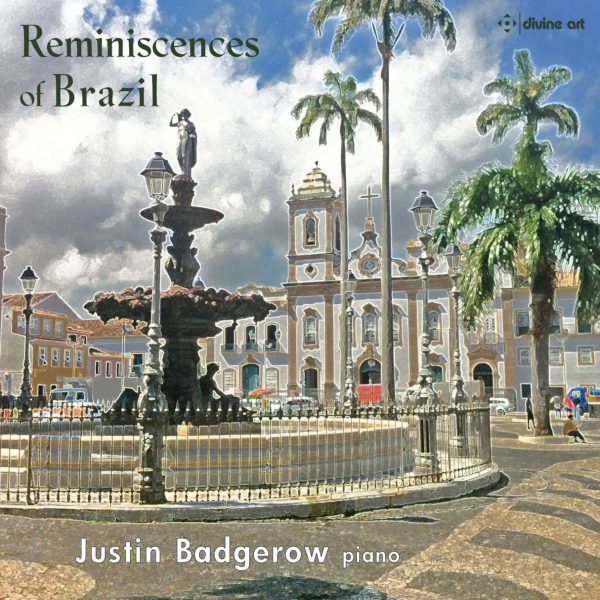Fanfare
The Divine Art label has been bringing out some splendid releases of late: among them, the Fitzwilliam String Quartet’s Schubert disc on original instruments stands out. Here is the American pianist Justin Badgerow, a fine musician who received his Doctorate from the University of Colorado at Boulder and splits his time between solo performance and teaching. This is, amazingly, his debut recording. He is also a musicologist: his edition of Britten’s Young Apollo, offering a reduction of the orchestra for a second piano, has been authorized by Faber Music Limited.
The single line that initiates Francisco Mignone’s Preludios (1932, a transcription by the composer of an earlier orchestral work) speaks volumes; when warmth strolls in (only to be rudely interrupted) in the following allegro, it is as if Mignone is attempting to fill 58 seconds with maximal incident. Perhaps the most effective of the six is the final “Caiqaras.” Marked solenne, this is indeed a solemn processional. That shows Badgerow’s command of the large scale; he times it just right, his rhythm unshakeable.
The move to Villa-Lobos’s Bachianas brasileiras takes us to more familiar territory. This, his Fourth, is the only one for piano solo (composed 1930-36). One can hear Bach’s organ works in the background of the “Preludio”; and again, that solid rhythmic sense holds Badgerow’s interpretation in good stead. His projection of line and weighting of chords are both deeply considered, beautifully captured in Michael Lippard’s recording. Interestingly, the “Coral (Canto do Sertão)” itself comes across as a baritone aria, the line beautifully sculpted above a firm bass and beyond a bell-like treble. That bell is initially transferred to the bass for the movement actually entitled “Aria (Cantiga)” before the open-air, chattering finale, “Dança” combines Debussyan harmonic sophistication with South American sultriness. It is Badgerow’s mastery of the pedal that shines here, enabling every strand to register. Moving to the two pieces from Ciclo Brasileiro (1936), we are offered an oasis of calm in “Plantio do Cabocio” (and indeed there does seem to be a watery element here), a chordal melody in the left-hand impeccably decorated by right-hand filigree. Villa-Lobos’s quinpartite exploration of the waltz in “Impressoes Seresteiras” is a sort of sultry version of Ravel’s La valse, but no less interesting. Badgerow’s technique is superb, most evidently in the accuracy and variety of the right-hand swirling figures.
One does not need a playlist to know when we move off-piste, from Villa-Lobos to the blissfully wonky sonorities of Darius Milhaud and his Saudades do Brasil, op. 67 (1920-21). There are 12 movements, each named after a different district of Rio de Janeiro. We hear four of them, in the order 4, 1,9, then 5. Badgerow captures the deliciously bittersweet wit of “Sorocaba” as easily as he does the soft sway of the hips in “Sumare” and the drive of “Ipanema” (he brings off the enigmatic end of this last piece brilliantly, too).
There follows a swathe of some eight stand-alone pieces; Mignone’s gracious, slightly harmonically spicy Valse Elegante offers a nostalgic reminder of times past (how beautiful again is Badgerow’s way with projecting melodic lines from within a texture!) in salon music par excellence.
The syncopations of Paulo Gondim’s Gingado do Bibi veer temptingly towards the sphere of jazz (wherein I suspect Badgerow might similarly excel) before Sonhando (1955), a piece where again one does not need a translation to know from the music itself that this means “dreaming” in Portuguese. The pieces Gingado do Bibi, Sapeca and Fim de tarde em Amargosa were all composed much later, between 2008 and 2010. The infectious Sapeca (a Portuguese word for “mischievous”) leads to the more reflective, crepuscular Fin de tarde em Amargosa and the more resolute Teimosia (the title does, after all, mean “stubbornness”) with its almost pecking staccatos. The warm embrace of Mozart Camargo Guamieri’s Danza Brasileira of 1928 offers (foot-tapping) respite before we return to where we started, with music by Mignone: the Congada, with its samba rhythms, rounds the disc off nicely. The whole provides a bright, colorful voyage into music inspired by the sights, sounds, and dances of Brazil. Most enjoyable.
@divineartrecordingsgroup
A First Inversion Company
Registered Office:
176-178 Pontefract Road, Cudworth, Barnsley S72 8BE
+44 1226 596703
Fort Worth, TX 76110
+1.682.233.4978












